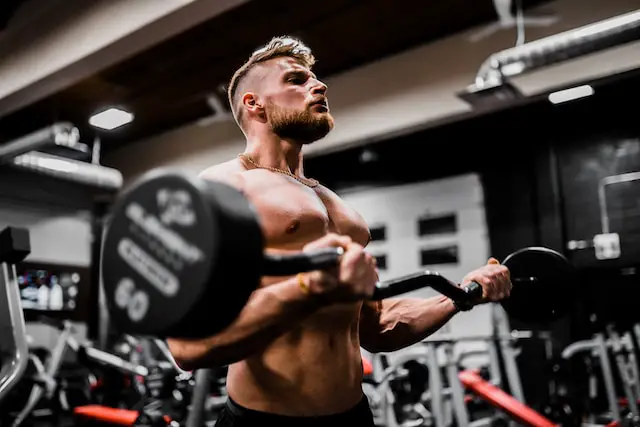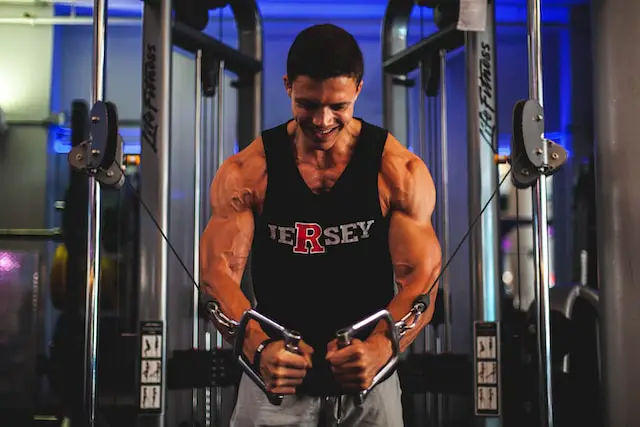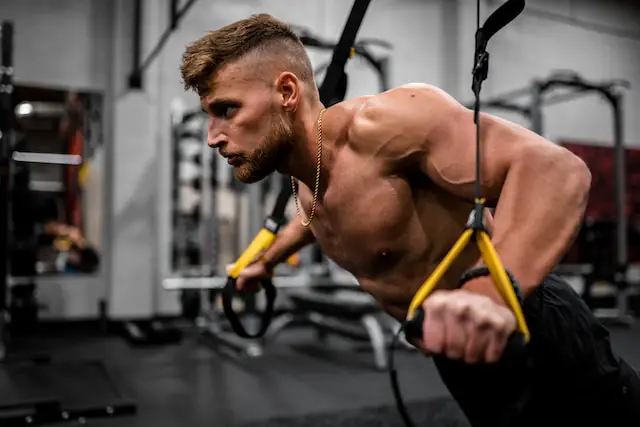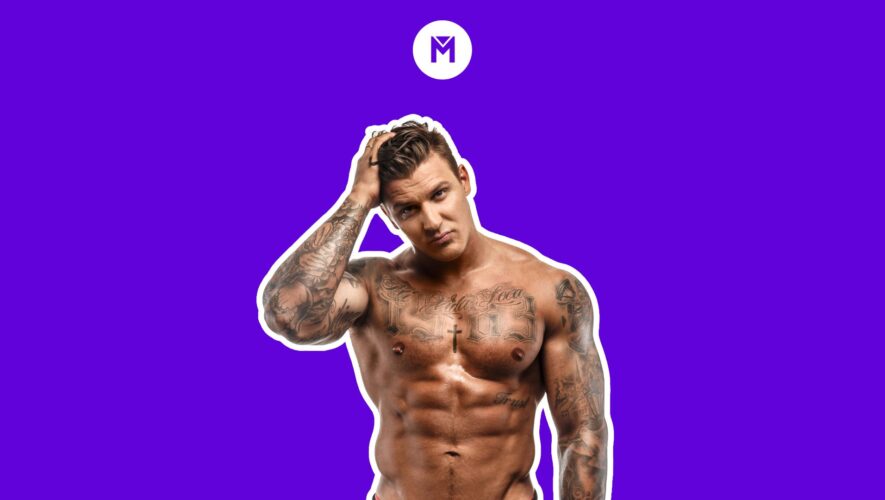Do you know what’s really frustrating? Hitting the gym every day and not seeing the results you expected.
Then you find people telling you to try this workout or that workout, and it gets all fussy.
Your body isn’t growing simply because you do not have a power-loaded plan like the Push Pull Legs Routine in place.
Building an incredible physique is hard work. It’s not something you can achieve overnight.
Think of your body as a big, solid rock that needs chiseling into a work of art.
How do you do that? You take a strategic approach to shape your body.

That’s where the Push Pull Legs Routine comes in.
Putting your efforts into this routine, with persistence and discipline, can build you a body way better than you possibly imagined.
All it will take is about 12 weeks to start seeing results, and it only gets better after that.
The PPL Routine has worked wonders for millions of men around the world who’ve set out to build muscle.
So without wasting any time, let’s get into it.
What is a Push Pull Legs Routine?
Also known as the PPL workout, this is a weightlifting training split where three types of workouts targeting three muscle groups are performed on separate days.
Push Workout: Targeted at the upper body, including your chest, shoulders, and triceps.
Pull Workout: Focused on the back, traps, biceps, and abs in some cases that require pulling.
Legs Workout: Training the calves, glutes, quads, and hamstrings.
These three workouts are performed on separate days allowing each muscle group to get adequate rest while they build themselves.

ALSO READ: Yoga for men: 18 Poses, Benefits & Pro Tips
Benefits of a PPL Split
The Push Pull Legs Routine has been around forever.
It has been the go-to-split for anybody starting off on their bodybuilding journey.
Athletes use the PPL split to build muscle mass and strength sustainably.
While this routine brings many benefits with it, some of the most popular benefits of a PPL workout are:
Time Efficient
In our fast-paced lives, finding the time to perform a full-body workout multiple times a week can be challenging. This is where the PPL routine shines.
It provides a fantastic alternative, allowing you to dedicate focused sessions on pushing exercises, pulling exercises, and leg workouts.
By doubling your training intensity on weekends and maintaining a moderate workload on weekdays, you can effectively manage your time.
Awaken your Weaker Muscles
The beauty of the PPL routine lies in its customization.
You have the freedom to adjust the repetitions and intensity based on your individual muscle strengths and weaknesses.
This enables you to address any muscular imbalances by specifically targeting and prioritizing your weaker muscles during your workouts, facilitating their growth and development.
Builds Muscle Mass
A well-designed PPL routine promotes balanced muscle development throughout your entire body.
It ensures that no particular body part is neglected while emphasizing overall muscle growth.
It’s important to note that proper nutrition, including a high-protein diet, plays a crucial role in supporting and maximizing the results of your PPL workouts.
Customized Training Split
The PPL routine offers remarkable flexibility, allowing you to customize it according to your schedule and preferences.
You can adjust the training frequency to suit your needs while ensuring that you target all three major muscle groups (push, pull, and legs) every week.
It is recommended to incorporate 48-72 hours of rest between workouts to allow for proper muscle recovery and growth.
Micro-Targeted Building
With the PPL routine, you have the advantage of targeting specific muscle groups during each session.
This focused approach allows you to dedicate more repetitions and attention to individual muscle groups compared to a full-body workout.
The increased emphasis and intensity result in enhanced muscle stimulation, leading to significant gains over time.
Balanced Stimulation
Since each workout is dedicated to a specific muscle group on separate days, there is no overlap or excessive strain on any particular muscle.
This helps prevent overstimulation and reduces the risk of injury.
By providing dedicated workout days for each muscle group, the PPL routine optimizes muscle growth and development.
ALSO READ: Carnivore Diet Meal Plan: The Ultimate Guide (Free PDF)
What does a Push Pull Legs Routine look like?
The basic idea behind a Push Pull Legs routine is similar for all lifters, but there are certain differences for beginners versus advanced lifters.
The major difference between a beginner and an advanced Push Pull Legs routine is the number of training days.
A beginner usually attempts three workouts a week, with one-day breaks in between splits.
An intermediate lifter will train for two days on and one day off for all muscle groups.
An advanced lifter, however, will push the limits of the body by regularly targeting each muscle group for six days on and one day off.
This PPL Split will boost the frequency of muscle stimulation as well as good recovery.

Advanced lifters can also add more complex exercises to this routine to enhance their muscle growth going forward.
However, remember not to overdo this routine, or you’ll end up damaging your muscles instead of building them.
Is the Push Pull Legs Split Good for Me?
The PPL split is a popular and effective workout routine that can yield significant results when done correctly. However, determining if it’s the right choice for you depends on various factors
Picking a specific Push Pull Legs Split depends on multiple factors that are both realistic and idealistic.
In the case of the Push Pull Legs routine, you have to consider these factors:
Strength Training Experience
Your prior experience with strength training plays a vital role in choosing a workout routine.
If you’re a beginner, a PPL split might still be suitable, but you may want to start with a more basic full-body workout to build a foundation.
On the other hand, if you have some experience, a PPL split can help you target specific muscle groups more effectively.
Weekly Schedule
Your availability and the number of days you can commit to working out each week are crucial.
A traditional PPL split typically involves three separate workouts for push, pull, and legs, which you’d perform on different days.
If you can consistently allocate these days to your training, a PPL split can be a good fit. However, if your schedule is limited, you might want to explore other options.
Age and BMI
Age and BMI can affect how your body responds to exercise. Younger individuals often recover more quickly and may handle higher training volumes.
Older individuals may need more rest and recovery time. Your BMI can also influence the type of exercises that are best for you.
If you’re at an extreme end of the BMI spectrum, you might need specialized guidance.
Injuries or Health Concerns
If you have any pre-existing injuries or health concerns, they must be taken into account.
Some exercises in a PPL routine could exacerbate certain injuries, while others might be beneficial for rehabilitation.
It’s essential to consult with a healthcare professional or physical therapist to adapt the routine to your specific needs.
Personal Goals for Growth
Your fitness goals are a critical factor in determining the effectiveness of a PPL split.
If your primary objective is to gain muscle mass and strength, a PPL routine can be an excellent choice, as it allows for targeted muscle group training.
However, if your goals are different, such as weight loss or overall fitness, you might consider alternative routines.
Timeline for Achieving Goals
The speed at which you want to achieve your fitness goals matters.
A PPL split can be demanding, and it often requires patience and consistency to see significant progress.
If you’re looking for rapid results, you might need to adjust your expectations or choose a different workout regimen.
Once you consider these factors and feel you can do it with consistency, it’s a GO for you.
PPL for Beginners
For a complete beginner who has no strength training experience, this is a perfect go-to PPL routine to follow.
Follow this workout schedule in the next 4-6 weeks, and you’ll see a slightly grown body in your mirror.
P.S. This is the beginning of the journey.
Here’s how your week will go:
- Day 1 – Chest, Shoulders, and Triceps
- Day 2 – Rest day
- Day 3 – Back, Biceps, and Abs
- Day 4 – Rest day
- Day 5 – Legs
- Day 6 – Rest day
- Day 7 – Rest day
PPL for Intermediate Lifters
This is a slightly advanced workout for intermediate lifters who’ve had a decent experience in strength training and especially a Push Pull Legs Routine.
In this schedule, you’ll be powering up your muscles in a 3 On and 1 Off split.
So if you’re following a calendar, try making slight changes to your weekly schedule.
Here’s how your week will go:
- Day 1 – Chest, Shoulders, and Triceps
- Day 2 – Back, Biceps, and Abs
- Day 3 – Legs
- Day 4 – Rest
- Day 5 – Chest, Shoulders, and Triceps
- Day 6 – Back, Biceps, and Abs
- Day 7 – Legs
After completing seven days, the eighth day will be a rest day, and the same split will start again for the week to come.
PPL for Advanced Lifters
This is an advanced workout because you’ll stimulate the muscle groups daily.
Avoid this split if you have little to no strength training experience.
This is the most powerful of the three Push Pull Legs Splits because of increased frequency in muscle stimulation.
Here’s how your week will go:
- Day 1 – Chest, Shoulders, and Triceps
- Day 2 – Back, Biceps, and Abs
- Day 3 – Legs
- Day 4 – Chest, Shoulders, and Triceps
- Day 5 – Back, Biceps, and Abs
- Day 6 – Legs
- Day 7 – Get rest
Push Pull Legs Routine: An Overview of Exercises
These are a set of exercises you should be targeting each day.
We’ve segregated them into three separate workouts that you can integrate into your routine depending on which one you’ve picked.
Some people even add in Cardio Workouts to cut fat faster and reveal those chiseled muscles.

Push Workout (Chest, Shoulders, and Triceps)
- Flat Barbell Bench Press
- Seated Shoulder Press
- Incline Bench Press
- Flat Bench Dumbbell Flyes
- Dumbbell Lateral Raises
- Triceps Rope Pushdown
- EZ Bar Skullcrusher
Pull Workout (Back, Biceps, and Abs)
- Barbell Row
- Dumbbell Shrug
- Bent Over Dumbbell Row
- Deadlift
- Face Pull
- Hammer Curl
- Barbell Curl
- Concentration Curls
- Crunches
- Leg Raises
- Plank
Legs Workout (Quads, Calves, Glutes, and Hamstrings)
- Romanian Deadlift
- Leg Press
- Barbell Squat
- Barbell Lunges
- Calf Press
- Leg Curl
Recommended Exercises for PPL
Let us explore a few top exercises in the Push Pull Legs Routine that we’d recommend you keep in your PPL split.
Each exercise in this section can be performed for up to 4 sets with 10-12 reps.
Push (Chest, Shoulders, and Triceps)
Flat Barbell Bench Press
- Lie down on a bench with your feet firmly placed on the ground.
- Grasp the barbell with a grip slightly wider than the width of your shoulders.
- Slowly lower the bar towards your chest, keeping your elbows close to your body.
- Push the bar back up by straightening your arms, and then repeat the exercise.
Seated Shoulder Press
- Sit on a bench with your feet planted on the ground.
- Take two dumbbells and hold them with your arms above your shoulder.
- Slowly lift the dumbbells away from your shoulders towards the top.
- Repeat this exercise, moving at a controlled pace.
Incline Bench Press
- Lie down on an inclined bench.
- Grasp the barbell with a grip slightly wider than your shoulders.
- Slowly lower the bar towards your chest, keeping your elbows tucked in.
- Push the bar up by extending your arms upward, and then repeat.
Triceps Rope Pushdown
- Attach a rope to a cable machine and put it at the top end.
- Stand upright and lean your upper body slightly forward.
- Face the cable machine and grasp the rope with an overhand grip.
- Press the rope down, keeping your elbows in, then take it back up.
Pull (Back, Biceps, and Abs)
Bent Over Dumbbell Row(Single Arm)
- Put your right knee on a bench while your left foot is on the ground.
- Hold a dumbbell in your left hand, and put your right hand on the bench.
- Keeping your upper body straight, hinge forward at the waist.
- Pull the dumbbell up towards your chest, keeping your elbow in.
- Slowly lower the dumbbell back down to the ground.
Crunches
- Begin by lying on your back on the ground.
- Lift your knees, keeping your feet flat on the ground.
- Lift your upper body off the ground towards your knees.
- Hold this position for a second, then slowly lower your upper body back down.
Pull-ups
- Find a sturdy bar that is higher than your height and can support your weight.
- Grasp the bar with a shoulder-width grip.
- Use your hands to pull your body up towards the bar.
- Continue pulling until your chin crosses the bar.
- Hold yourself in this position for two seconds, then slowly lower yourself back down.
Legs (Quads, Calves, Glutes, and Hamstrings)
Leg Press
- Sit in a leg press machine at an angle of 30-45 degrees, resting your back.
- Adjust the weight on the machine, and position your feet shoulder-width apart.
- Lower the footplate with your feet, then push it back up to its starting position.
Barbell Squat
- Grasp a barbell and hold it on your upper back.
- Lift your chest and keep your back straight throughout the exercise.
- Lower your body down as far as possible, then push yourself back up.
Leg Curl
- Begin by lying face down on a leg curl machine.
- Attach your ankles to the footpad, ensuring that your legs are straight.
- Set the weight according to your preference.
- Curl your heels upwards, as close to your buttocks as possible.
- Slowly return to the starting position, maintaining control.
Frequently Asked Questions
Here are some frequently asked questions about the Push Pull Legs routine, and we thought to answer them so you don’t remain confused about the magic of this workout split.
Is a 6-Day PPL split too much?
A 6-day split can injure your muscles and make it harder for you to carry on, especially if you’re a beginner. It’s best to carry on with a basic PPL split.
Is Push Pull Legs 3 days a week enough?
If you have little to no strength training experience, you should start with a 3-day split with three rest days between them to avoid injuries and burnout.
Can absolute beginners do a Push Pull Leg split?
Yes, but with low intensity and frequency. Working out three days a week with three rest days is a good start for beginners, even if you’ve never worked out before.
Is PPL a good split for muscle growth?
Yes. Push Pull Legs routine is known around the world for its insane abilities to stimulate muscle growth, and when combined with the right diet, it can do wonders for you.
Which is better, PPL or Bro split?
While Bro split is very popular, research indicates that it doesn’t boost muscle mass at the same rate as a Push Pull Leg split. PPL is known to perform exceptionally for all individuals.
The Bottomline
Depending on your strength training experience, personal goals, and health factors, you’re now equipped to decide on a good training split.
We would personally recommend a Push Pull Legs Routine because we’ve seen it work for thousands of men.
While the PPL routine may not be the best fit for everyone, another training split may be a better choice depending on your unique circumstances and goals.
Consult with a fitness professional or trainer to determine which split suits your needs.
However, if you’re only trying to lose weight, we’d recommend you try out a Keto Diet or burn 500 calories a day.
All the best, King!



